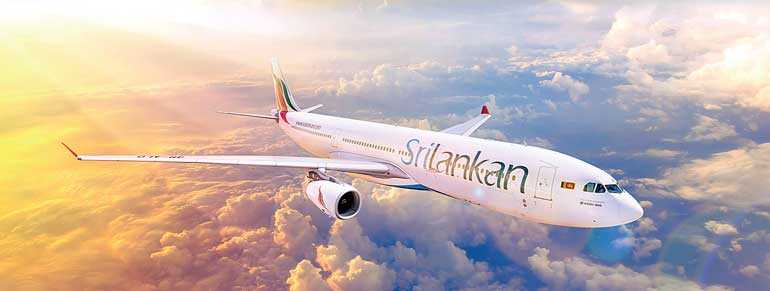Sunday Mar 09, 2025
Sunday Mar 09, 2025
Monday, 2 September 2019 00:00 - - {{hitsCtrl.values.hits}}

Exactly 40 years ago on 1 September 1979, the first flight of SriLankan Airlines was made, the aircraft rising gracefully from Colombo’s Bandaranaike International Airport to wing its way to Bangkok. It was the modest start of the National Carrier’s four decades as the mainstay of air travel and air cargo transportation for the island nation’s economy.
Today, SriLankan Airlines is a global award winning airline that carries millions of passengers each year with a route network of 109 cities in 48 countries, including codeshare operations in partnership with the world’s finest airlines. It is firmly established as one of the leading airlines in the Indian Ocean region, being the largest carrier to both Sri Lanka and the Maldives, and the largest foreign airline in India.
SriLankan Airlines Group CEO Vipula Gunatilleka said: “Our objective is to become the most customer-centric airline in Asia, both in the air and on the ground, building on our four decades of excellence in customer service for which we have won numerous international accolades with our emphasis on safety, punctuality and service.”
A member of the prestigious oneworld global airline partnership, SriLankan Airlines also connects travelers to over 1,000 cities in 160 countries through its oneworld partner airlines. Travellers get to enjoy SriLankan’s all-Airbus fleet of modern aircraft with their latest on-board comforts such as flatbeds in Business Class and sophisticated in-flight entertainment that complement its world class service. With SriLankan being repeatedly named one of the most punctual airlines in the world, they also get to enjoy on-time departure and arrival, a rarity in air travel.
But SriLankan isn’t only an airline. To support the operations of every airline that flies to Colombo, SriLankan has built up numerous support services with their own unique brands and identities. SriLankan Ground Handling is the ground handler caring for passengers of all airlines at the country’s two international airports; SriLankan Cargo works closely with all economic sectors to support the country’s economy and as one of the most important logistics links for the country’s economy, it carries imports, exports, mail and much more; SriLankan Engineering provides engineering and maintenance facilities for all airlines at BIA; the SriLankan Aviation College is one of the more reputed aviation training academies in the region, grooming future aviation professionals from many countries; and SriLankan Holidays is involved in leisure travel packages, both inbound and outbound.
SriLankan Catering, its fully-owned subsidiary, has won several international awards for its in-flight catering expertise that serves all airlines at BIA, and recently announced the launch of a Rs. 250 million project for a sophisticated new flight kitchen which would increase its production capacity to 40,000 meals per day. Throughout much of its history, the National Carrier unflinchingly shouldered the additional responsibility of providing smooth air services during the country’s many crises ranging from the civil war to the 2004 tsunami, with the latest emergency being the Easter Sunday attacks.
While many airlines have ceased operations to Colombo from time to time, sometimes for several years, SriLankan has continued to persevere in order to provide a solid air travel network for the country to depend on. It has especially focused on the struggling tourism industry which benefits immensely from the airline’s global marketing efforts in promoting leisure and business travel to the island.
The airline has now embarked upon a new Business Plan that is aimed at turning around the company to profitability in the shortest possible time.
Gunatilleka added: “Our staff has been our biggest strength and we look to them to ring in many changes to help SriLankan evolve. Next year, new destinations such as Ahmedabad, Calicut, Kathmandu, Saigon and Sydney will be added and several code-share agreements have been finalised with carriers from Africa, Middle East and the Far East to bridge the gaps in our network. What do we do to reduce carbon emissions and use of plastic on board? We are implementing many cost saving initiatives including fuel saving measures for our fleet. At the same time, the impact of global terrorism, trade tensions and climate change must be addressed.”
Discover Kapruka, the leading online shopping platform in Sri Lanka, where you can conveniently send Gifts and Flowers to your loved ones for any event including Valentine ’s Day. Explore a wide range of popular Shopping Categories on Kapruka, including Toys, Groceries, Electronics, Birthday Cakes, Fruits, Chocolates, Flower Bouquets, Clothing, Watches, Lingerie, Gift Sets and Jewellery. Also if you’re interested in selling with Kapruka, Partner Central by Kapruka is the best solution to start with. Moreover, through Kapruka Global Shop, you can also enjoy the convenience of purchasing products from renowned platforms like Amazon and eBay and have them delivered to Sri Lanka.
Discover Kapruka, the leading online shopping platform in Sri Lanka, where you can conveniently send Gifts and Flowers to your loved ones for any event including Valentine ’s Day. Explore a wide range of popular Shopping Categories on Kapruka, including Toys, Groceries, Electronics, Birthday Cakes, Fruits, Chocolates, Flower Bouquets, Clothing, Watches, Lingerie, Gift Sets and Jewellery. Also if you’re interested in selling with Kapruka, Partner Central by Kapruka is the best solution to start with. Moreover, through Kapruka Global Shop, you can also enjoy the convenience of purchasing products from renowned platforms like Amazon and eBay and have them delivered to Sri Lanka.